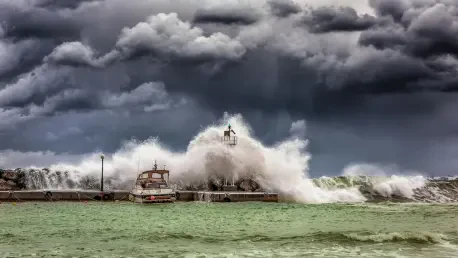Storm-Driven Disruptions in Coastal Economies
Imagine a storm so powerful that, even hundreds of miles offshore, it forces entire communities to evacuate, shutters businesses, and sends insurance markets into a tailspin. This is the reality unfolding along North Carolina’s Outer Banks as Hurricane Erin, with sustained winds of 110-115 mph, generates massive swells that batter the East Coast. This analysis examines the economic implications of such climate-driven disruptions, focusing on how offshore hurricanes impact local markets, insurance sectors, and infrastructure investments. The purpose is to uncover critical trends and projections that can guide stakeholders in navigating these turbulent times.
Market Trends and Economic Projections
Swell of Challenges: Tourism and Local Business Impacts
Hurricane Erin’s towering waves, reaching 15-20 feet along the coast and up to 30 feet offshore, have triggered mandatory evacuations in areas like Hatteras Island and Ocracoke Island. This displacement halts tourism—a lifeline for many coastal economies—during what should be a peak season. Hotels, restaurants, and recreational businesses face immediate revenue losses as no-swim advisories and beach closures stretch from North Carolina to New Jersey. The ripple effect is stark: local vendors lose foot traffic, and seasonal workers encounter sudden income gaps.
Beyond short-term hits, the broader market trend reveals a growing fragility in tourism-dependent regions. Data suggests that coastal businesses often take months to recover from such disruptions, with some smaller enterprises never reopening. Projections indicate that if storm frequency increases as expected, annual losses in this sector could rise by 20-30% over the next decade, pushing communities to diversify economic bases or risk collapse.
Insurance Sector Pressures: Coverage Gaps and Rate Spikes
Another critical trend lies in the insurance market, where Hurricane Erin exposes deep vulnerabilities. With less than 3% of homes in North Carolina and 9% in South Carolina carrying flood insurance, the financial burden of damages falls heavily on property owners. Insurers, already reeling from past disasters like Hurricane Helene—which caused over $53 billion in losses in North Carolina—are now seeking rate hikes averaging 42% statewide, with coastal zones facing even steeper increases.
This pattern of escalating premiums and low coverage paints a grim picture for market stability. Analysts project that without significant policy interventions, the insurance sector could see a 50% drop in policyholders willing to pay rising costs by 2027. Such a trend risks creating a vicious cycle where uninsured losses strain public resources, further destabilizing local economies. The market must grapple with balancing risk assessment against affordability to prevent widespread financial distress.
Infrastructure Investments: Erosion of Assets and Future Costs
The storm’s swells are not just a threat to lives but also to physical assets, with severe beach erosion threatening protective dune systems along Cape Hatteras. Infrastructure like N.C. Highway 12, vital for evacuations and commerce, faces potential closures, amplifying costs for repairs and emergency responses. The National Park Service has flagged the long-term degradation of coastal defenses as a pressing concern, noting that each storm chips away at already strained budgets.
Market analysis points to a growing need for capital investment in resilient infrastructure, with current funding levels falling short of projected needs. Estimates suggest that fortifying coastal defenses could require a 35% increase in state and federal allocations over the next five years. Without such commitments, the economic toll of recurring damages will likely outpace recovery efforts, burdening taxpayers and stunting regional growth.
Reflecting on Economic Lessons and Strategic Pathways
Looking back, the impact of Hurricane Erin revealed how even an offshore storm could disrupt coastal markets through evacuated communities, shuttered businesses, and strained insurance systems. The analysis underscored critical gaps in flood coverage and infrastructure readiness, which left local economies vulnerable to cascading losses. These findings highlighted the urgent need for systemic reforms to shield markets from future climate-driven shocks.
Moving forward, stakeholders should prioritize expanding affordable insurance programs to close coverage gaps and mitigate financial fallout. Investing in robust dune restoration and roadway reinforcements offers a tangible way to protect economic assets against erosion and flooding. Additionally, diversifying coastal economies beyond tourism could provide a buffer against seasonal disruptions. These strategic steps, if implemented proactively, stand to build a more resilient market framework capable of weathering the next storm’s swell.









